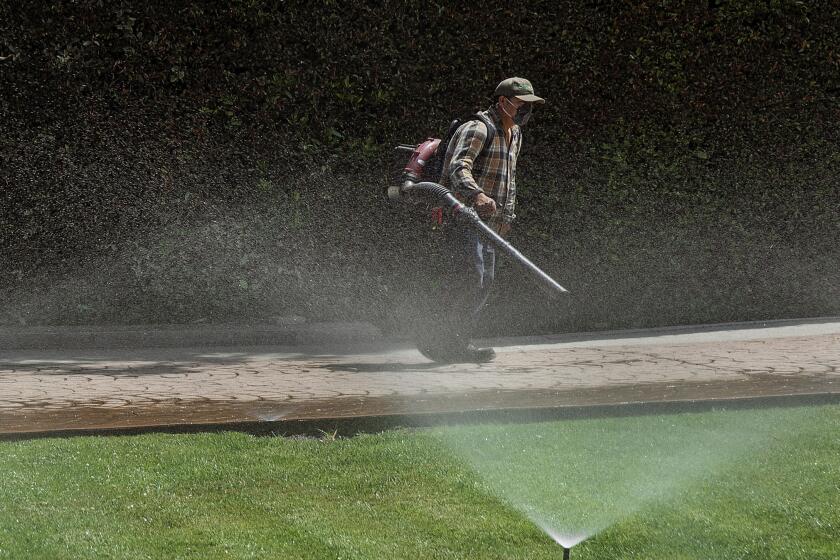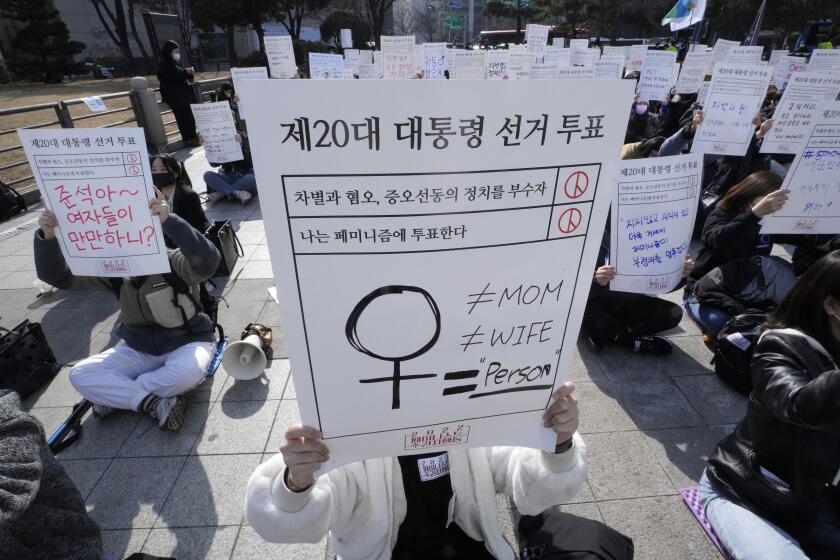Colombian Growers Pushing New Brand of Flower Power
- Share via
Consider the plight of the Colombian flower grower.
Peddling his blossoms in the world export market, he has to compete for publicity with that more famous Colombian-produced commodity, cocaine. He has to guide each shipment of roses and carnations through a gantlet of suspicious U.S. Customs inspectors and probing X-ray machines. He has to avoid undue delays lest his wares wilt into worthlessness.
Now he is taking on one more challenge: gaining a stronger foothold in California, a state that leads the nation in domestic flower production and where competition is stiff.
“We want to start things on the West Coast,” said Douglas Montgomery, director of the Colombian Government Trade Bureau. “We believe there is a trend toward increased usage of flowers, and California is a nice market.”
To that end, five of Colombia’s leading flower growers showed off samples of their crop to California-based wholesalers in an exhibition at the Century Plaza Hotel this week--while bemoaning the travails of working in an industry plagued by the fallout from a raging drug war.
The goal, Montgomery said, is to convert Los Angeles into a hub for the Colombian flower trade, as a springboard for sales throughout the West Coast and Pacific Rim.
Colombia already is the United States’ largest foreign supplier of fresh-cut flowers. The principal port of entry is Miami. From there, flowers destined for the West have to be reloaded on flights to California or trucked cross-country.
To reach Japan, another major buyer of Colombian flowers, producers ship from Bogota through Frankfurt, West Germany, then around the world to Japan, a journey of 2 1/2 days. To ship from Bogota through Los Angeles would take only 20 hours, Montgomery said.
Colombian growers are treading into the local market “timidly,” Montgomery said, to avoid antagonizing California producers. With land and labor much cheaper in Colombia, relatively inexpensive flowers such as carnations can be produced more economically there.
Colombian flowers--which represent a $200-million-a-year business for that nation--are available year-round, producers say, because they are grown on the high-altitude, temperate Bogota savanna.
Not surprisingly, it is the California growers who are most alarmed at the expanding presence of Colombian blossoms in West Coast florist shops.
“The Colombians are getting away with murder,” Raymond Hasek, executive vice president of the California Floral Council, said, referring to the low prices the Colombian producers charge. “We’ve lost a heck of a lot of carnation growers and pompon growers. They can’t compete with the price.”
For Los Angeles to become a key component of the Colombian flower trade, importers and shippers will have to build up a better infrastructure at the airport, including refrigerated warehouses, Montgomery said. The only airline that flies from Bogota to Los Angeles will have to be persuaded to allow Colombian flowers into its cargo holds, he added.
On a few occasions, U.S. Customs Service officials said they have found cocaine hidden inside flower shipments on the Colombian national airline, Avianca. That carrier’s planes were confiscated and the company had to pay huge fines--prompting it to refuse flower shipments.
Such are the pitfalls facing the growers and exporters of Colombia’s legitimate crops.
“Everything that comes up from Colombia is looked at with special care,” Montgomery said. “We used to have problems; the customs agents were very edgy about shipments from Colombia.”
Over the last couple of years, the flower industry has adopted extraordinary security measures to keep exports cocaine-free. Flowers are transported to the Bogota airport in hermetically sealed containers. Television cameras monitor the airport warehouses. Once in Miami, shipments are X-rayed repeatedly.
“They have it down to a science,” Montgomery said.
Although it may be a nuisance, importers such as Maureen Sneed say the security is well worth it.
“We are all for it (the security measures), and we help,” said Sneed, executive vice president of a Santa Ana-based importer, Proflora Ltd.
“You work hand in hand with the DEA,” she said, referring to the federal Drug Enforcement Administration. “The last thing we want is to have a problem.”
Certainly, it is better than the old days, Sneed said, when inspectors stuck metal poles through boxes of flowers to probe for drugs. Importers received their boxes looking as if they had been through a hole puncher, she said, with the flowers often mutilated.
The two-day flower show at the Century Plaza Hotel, which ended Tuesday night, featured the full variety of colors and species that Colombia produces. More than 100 white vases of red roses, purple agapanthuses, white lilies, yellow statices, and carnations and pompons of every color were on display.
“By promoting Colombian flowers, we are trying to rid Colombia’s image of words like cocaine, guerrillas and death,” said Armando Alvarado of Flores del Rio, one of the five largest Colombian growers. “It is not easy to remove such labels, but we hope to show there is something else” from Colombia.
More to Read
Sign up for Essential California
The most important California stories and recommendations in your inbox every morning.
You may occasionally receive promotional content from the Los Angeles Times.














